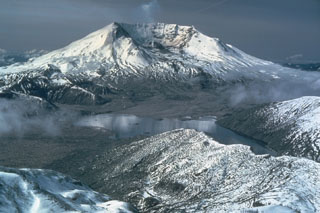Report on St. Helens (United States) — August 1983
Scientific Event Alert Network Bulletin, vol. 8, no. 8 (August 1983)
Managing Editor: Lindsay McClelland.
St. Helens (United States) Lava extrusion continues; internal dome growth accelerates; small fluidized avalanches; vapor and ash plumes
Please cite this report as:
Global Volcanism Program, 1983. Report on St. Helens (United States) (McClelland, L., ed.). Scientific Event Alert Network Bulletin, 8:8. Smithsonian Institution. https://doi.org/10.5479/si.GVP.SEAN198308-321050
St. Helens
United States
46.2°N, 122.18°W; summit elev. 2549 m
All times are local (unless otherwise noted)
New lava was still being added to the active lobe in early September and deformation of other parts of the dome was accelerating. The lobe front moved down the NE flank at about 1 m per day in August, roughly the same rate as in July. Rockfalls from the lobe's leading edge appeared to decline in July and August, but continued to remove some material, reducing the lava's net August advance to 20-25 m.
Rates of outward movement of survey targets on the S, SE, and N flanks of the dome began an irregular increase about 8 July and by early September had reached nearly 11 cm/day high on the S side. No acceleration of endogenous growth was observed in the area of most rapid deformation, below the active lobe on the NE flank, where rates averaged 60 cm/day. Movement of crater floor stations N and S of the dome was first detected around early August, gradually increasing into the millimeters per day range by early September. The pattern of increasing deformation was generally similar to periods that preceded extrusion of new lobes in 1981 and 1982. However, Donald Swanson noted that the irregular acceleration of endogenous growth contrasted with the quite steady increases measured before 1981-2 extrusion episodes, and that it was continuing after 2 months without the onset of new extrusion, exceeding the typical 1 month-6 week durations of the 1981-82 premonitory periods.
Numerous rockfalls, some quite large, occurred from a N-flank notch that was propagating upslope toward the dome's extrusive vent. This activity built a large structurally unstable talus slope of hot blocks. Upon reaching the talus, some rockfalls became fluidized, probably by entrainment of heated air from between talus boulders. Early 12 August, Daniel Dzurisin observed a group of large boulders from the notch bounce onto the talus. A few seconds later, a second rockfall reached the talus and fluidized. An ash cloud quickly formed over the avalanche, and moved downslope at the same speed as the entrained boulders, stopping as they came to rest. The avalanche formed a lobate deposit with marginal levees less than 1 m high. Fine particles extended to roughly the distal end of the boulder deposit. Ash clouds formed by smaller avalanches were diffuse enough so that boulders could be seen rolling slowly downslope; these avalanches seemed to be only partially fluidized. The avalanches traveled no more than several hundred meters beyond the base of the talus, into the large breach on the N side of the crater. For several days after a large rockfall, avalanches occurred roughly every 2 hours, but declined to 1-2/day during quiet periods.
Occasional ejection of steam-and-ash plumes continued from several vents in the broad summit region of the dome. The number of plumes varied from day to day, but generally ranged from three to six daily and remained relatively unchanged through the summer. Plumes typically rose about 1 km above the dome and deposits were usually limited to the dome's summit area. No projectiles from these plumes reached the crater floor in August. Tom Casadevall reported that COSPEC measurements indicate that the volcano emits more SO2 while plumes are being ejected than during quiet periods; on 18 August a plume briefly produced a 4-fold increase in SO2 emission. However, plume events normally last only 15-20 minutes, and the excess SO2 values decay exponentially, so they do not have a large effect on daily gas flux. The rate of SO2 emission averaged 70 ± 50 t/d in August, ranging from 40 to 90 t/d most of the month, but measurements 18-23 August yielded values of more than 150 t/d.
August seismic activity was generally similar to that of July. A substantial increase in surface events was recorded, but was thought to reflect increased avalanching from the crater walls as warm weather melted snow on the rim. For about 10 days in late August, the number of earthquakes and the rate of seismic energy release increased slightly, but declined to previous levels by early September.
Geological Summary. Prior to 1980, Mount St. Helens was a conical volcano sometimes known as the Fujisan of America. During the 1980 eruption the upper 400 m of the summit was removed by slope failure, leaving a 2 x 3.5 km breached crater now partially filled by a lava dome. There have been nine major eruptive periods beginning about 40-50,000 years ago, and it has been the most active volcano in the Cascade Range during the Holocene. Prior to 2,200 years ago, tephra, lava domes, and pyroclastic flows were erupted, forming the older edifice, but few lava flows extended beyond the base of the volcano. The modern edifice consists of basaltic as well as andesitic and dacitic products from summit and flank vents. Eruptions in the 19th century originated from the Goat Rocks area on the N flank, and were witnessed by early settlers.
Information Contacts: T. Casadevall, D. Dzurisin, D. Swanson, USGS CVO, Vancouver, WA; S. Malone, University of Washington.

